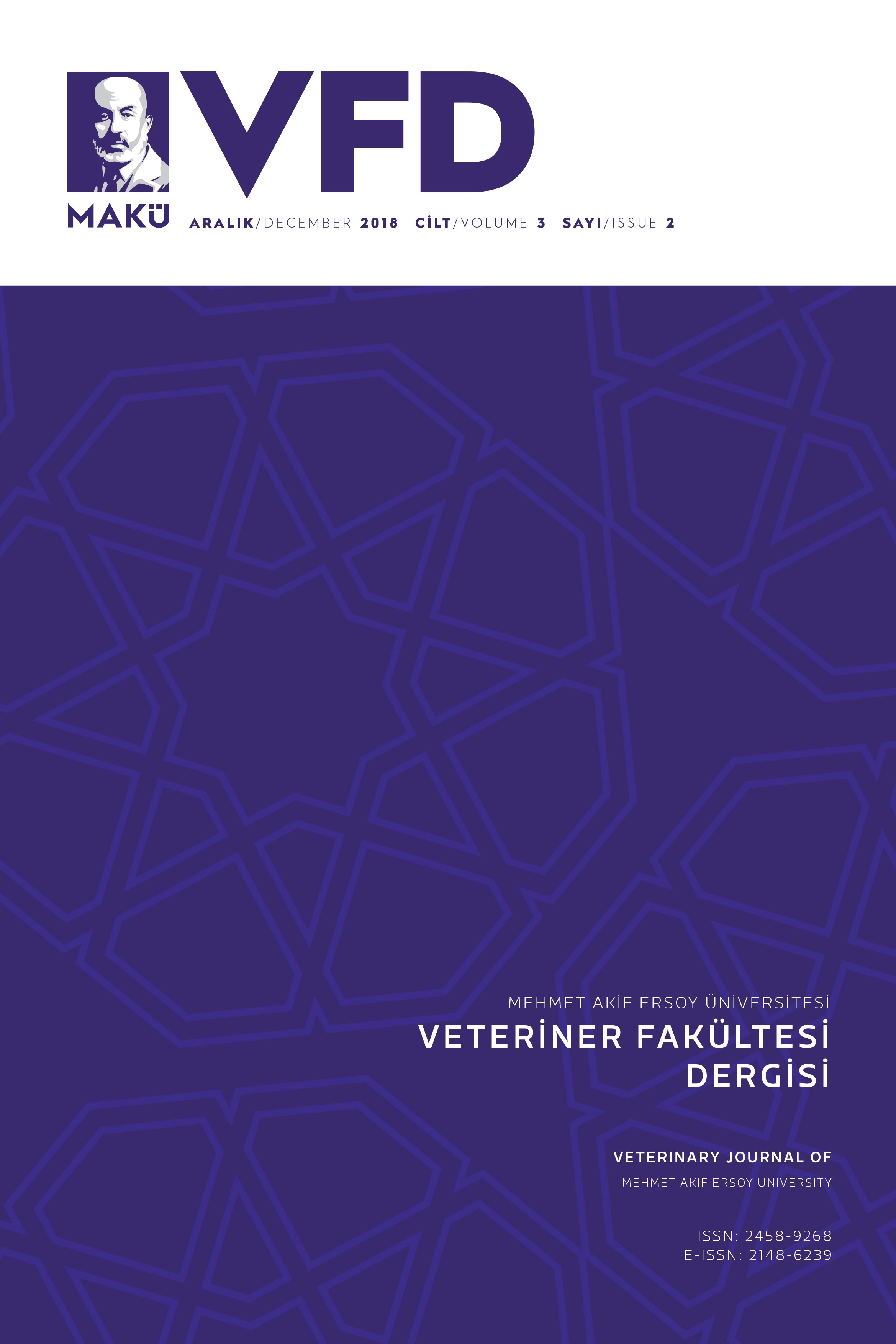Holştayn Düve ve İneklerde Serum Anti Müllerian Hormon Düzeyleri ile Fertilite İlişkisinin Araştırılması
Relationship Between Sera Anti Mullerian Hormone Levels and Fertility in Holstein Heifers and Cows
___
- 1. Akdağ T. Puberta öncesi ve sonrası sağlıklı erkek bireyler ile üroloji polikliniğine müraacat eden kriptorşit ve varikosel, oligospermi tanılı hastalarda AMH ve bazı biyokimyasal parametrelerin karşılaştırılmalı araştırmaları. Selçuk Üniversitesi Sağlık Bilimleri Enstitüsü, 2010, Konya, Türkiye.
- 2. Pfeiffer KE, Jury LJ, Larson JE. Determination of antimüllerian hormone at estrus during a synchronized and a natural bovine estrous cycle. Domestic Animal Endocrinology. 2014; 46: 58-64.
- 3. Yılmaz T. İn-vitro fertilizasyon ve embriyo transferi sikluslarında folikül sıvılarında antimüllerian hormon düzeyleri ile oosit, embriyo kalitesi ve gebelik sonuçları arasındaki ilişki. Yeniyüzyıl Üniversitesi Sağlık Bilimleri Enstitüsü, 2016, İstanbul, Türkiye.
- 4. Ribeiro ES, Bisinotto RS, Lima FS, Greco LF, Morrison A, Kumar A, Thatcher WW, Santos JEP. Plasma anti-Müllerian hormone in adult dairy cows and associations with fertility. J Dairy Sci. 2014; 97: 1-13.
- 5. Morotti F, Barreiros TRR, Machado FZ, González SM, Marinho LSR, Seneda MM. Is the number of antral follicles an interesting selection criterium for fertility in cattle. Anim Reprod. 2015;12(3): 479-486.
- 6. Jimenez- Krassel F, Scheetz DM, NeuderLM, Ireland JLH, Pursley JR, Smith GW, et al. Concentration of anti-müllerian hormone in dairy heifers is positively associated with productive herd life. J. Dairy Sci. 2015; 98: 1-10.
- 7. Su HI, Sammel MD, Homer MV, Bui K, Haunschild C, Stanczyk FZ. Comparability of antimüllerian hormone levels among commercially available immunoassays. Fertility and sterility, 2014; 101(6): 1766-72.
- 8. Rico C, Fabre S, Médigue C, di Clemente N, Clément F, Bontoux M, et al. Anti-mullerian hormone is an endocrine marker of ovarian gonadotropin-responsive follicles and can help to predict superovulatory responses in the cow. Biology of Reproduction, 2009; 80: 50-59.
- 9. Center K, Dixon D, Looney Charles, Rorie Rick (2018). Anti-Mullerian hormone and follicle counts as predictors of superovulatory response and embryo production in beef cattle. Advances in Reproductive Sciences, 6, 22-33.
- 10. Monniaux D, Clemente N, Touze JL, Belville C, Rico C, Bontoux M, et al. Intrafollicular steroids and Anti-Mullerian Hormone during normal and cystic ovarian follicular development in the cowl. Biol Reprod. 2008; 79: 387-396.
- 11. Ireland JL, Scheetz D, Jimenez-Krassel F, Themmen AP, Ward F, Lonergan P,et al. Antral follicle count reliably predicts number of morphologically healthy oocytes and follicles in ovaries of young adult cattle. Biol Reprod. 2008; 79(6):,1219-25.
- 12. Rico C, Drouilhet L, Salvetti P, Dalbiès-Tran R, Jarrier P, Touzé JL, et al. Determination of anti-Müllerian hormone concentrations in blood as a tool to select Holstein donor cows for embryo production: from the laboratory to the farm. Reprod Fertil Dev. 2012; 24(7): 932-44.
- 13. Mossa F, Walsh SW, Butler ST, Berry DP, Carter F, Lonergan P, et al. Low numbers of ovarian follicles ≥3 mm in diameter are associated with low fertility in dairy cows. J. Dairy Sci. 2012; 95: 2355-61.
- 14. Mossa F, Ireland JJ (2018). Anti-Müllerian Hormone (AMH): a biomarker for the ovarian reserve, ovarian function and fertility in dairy cows. Journal of Animal Science. 8, 48824-1225.
- 15. Souza AH, Carvalho PD, Rozner AE, Vieira LM, Hackbart KS, Bender RW, et al. Relationship between circulating anti-Müllerian hormone (AMH) and superovulatory response of high-producing dairy cows. J. Dairy Sci. 2015; 98: 1-10.
- Başlangıç: 2016
- Yayıncı: Burdur Mehmet Akif Ersoy Üniversitesi
Epidemiological modelling in infectious diseases: stages and classification
Özge YILMAZ ÇAĞIRGAN, Abdurrahman CAGIRGAN
Medical Management of Hemorrhagic Bowel Syndrome in Cattle
Joseph SMİTH, Paul MERKATORİS, Ryan BREUER, Cassandra KLOSTERMANN, Jonathan MOCHEL
İneklerde Ksilazin-Lidokain veya Deksmedetomidin-Lidokain Karışımları ile Epidural Anestezi
Yusuf SİRİN, Kürşad YİĞİTARSLAN, Özlem ŞENGÖZ ŞİRİN
Normative ranges of tympanometric measurements in cats
Yusuf SİRİN, Özlem ŞENGÖZ ŞİRİN
Türkiye’de yunus parkları üzerine bir değerlendirme*
Gökhan ASLIM, Ali YİĞİT, Çağrı Çağlar SİNMEZ, Aşkın YAŞAR
Tetralogy of Fallot in a Two-Month-Old Holstein Calf
S.serap BİRİNCİOĞLU, Emrah İPEK, Ayşe Nur AKKOÇ, Hamdi AVCI, Ahmet AYDOĞAN
Investigations of Cardiac Functions and Organ Damages in Neonatal Calves with Suscepted Sepsis
Yasemin BEYDİLLİ, Halil İbrahim GÖKÇE
Konya bölgesindeki hindi yetiştiriciliğinin mevcut durumu ve bazı sorunlarının değerlendirilmesi
